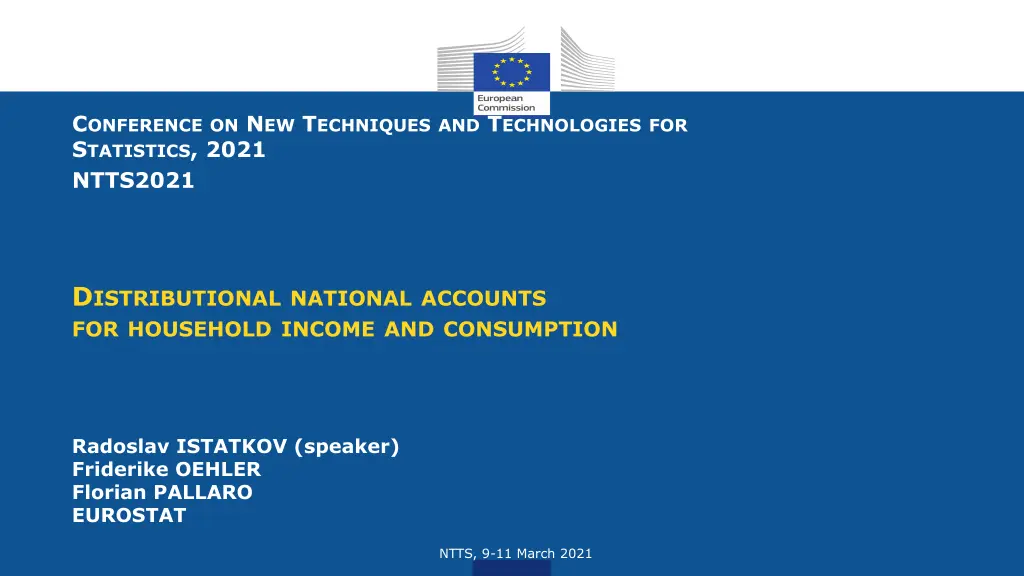
Innovative Techniques for Distributional National Accounts and Social Indicators
Explore the latest methodologies and results from the NTTS 2021 conference on household income and consumption distributional national accounts. Discover how sensitivity indicators impact disposable income and consumption, with a focus on clustering households and measuring social impacts of economic policies.
Download Presentation

Please find below an Image/Link to download the presentation.
The content on the website is provided AS IS for your information and personal use only. It may not be sold, licensed, or shared on other websites without obtaining consent from the author. If you encounter any issues during the download, it is possible that the publisher has removed the file from their server.
You are allowed to download the files provided on this website for personal or commercial use, subject to the condition that they are used lawfully. All files are the property of their respective owners.
The content on the website is provided AS IS for your information and personal use only. It may not be sold, licensed, or shared on other websites without obtaining consent from the author.
E N D
Presentation Transcript
CONFERENCE ON NEW TECHNIQUES AND TECHNOLOGIES FOR STATISTICS, 2021 NTTS2021 DISTRIBUTIONAL NATIONAL ACCOUNTS FOR HOUSEHOLD INCOME AND CONSUMPTION Radoslav ISTATKOV (speaker) Friderike OEHLER Florian PALLARO EUROSTAT NTTS, 9-11 March 2021
Background Need for reinforced social indicators in line with the EU reinforced macroeconomic governance help assess social impacts of economic policies and economic impacts of social policies Eurostat centralised exercise for compiling distributional national accounts for household income and consumption 2 NTTS, 9-11 March 2021
Methodology: data sources Input data National accounts for sector Households Adjusted for population not covered in social surveys (mainly institutional households) EU-SILC (income) and HBS (consumption) Reference year Income 2015 Consumption as reported within HBS 2015 wave Item breakdown Income: 10 aggregate income items Consumption: 12 main COICOP categories 3 NTTS, 9-11 March 2021
Methodology: micro-macro gap allocation methods M.1 Proportional allocation Gap distributed proportionally over households Micro data distribution is close to the "real" distribution M.2 Pareto tail modelling Top 10% households adjusted to conform to a Pareto distribution Remaining gap allocated proportionally over all households M.3 Ascending/descending gap shares by quintile M3.1: gap shares 0%, 10%, 20%, 30%, 40% to Q1, Q2, Q3, Q4, Q5 M3.2: gap shares 40%, 30%, 20%, 10%, 0% to Q1, Q2, Q3, Q4, Q5 M.4 Combined approach M.2: property income (received) , mixed income , wealth taxes M.1: all other items 4 NTTS, 9-11 March 2021
Results Clustering households Quintiles according to equivalised total disposable income Modified OECD equivalence scale Accounts for differences in the size and composition of households Sensitivity analysis Measuring the impact of method choice Indicators Gini coefficient, % Q5/Q1 ratio 5 NTTS, 9-11 March 2021
Conclusion: sensitivity indicators (disposable income) 6 NTTS, 9-11 March 2021
Conclusion: sensitivity indicators (consumption) 7 NTTS, 9-11 March 2021
Thank you Results published as experimental statistics https://ec.europa.eu/eurostat/web/experimental-statistics/ic-social- surveys-and-national-accounts E-mail: ESTAT-ICW@ec.europa.eu 8 NTTS, 9-11 March 2021



